Excel simply doesn’t excel anymore. It may have ruled the roost for a while when it came to asset tracking, but today, there are far better options out there. If you’re debating asset tracker Excel pros and cons, we can tell you why you’re better off choosing a more efficient option like asset tracking software from ToolSense.
The Status Quo of Excel Asset Tracking
From inventory to invoices, asset management in Excel is a popular choice for companies both yesterday and today for two main reasons:
- Familiar: Most employees have at least heard of Excel and know how to use its basic features.
- Loaded: Excel is packed with all kinds of features and specifically designed for businesses.
Excel seemed like it had practically anything you could think of. Formulas, pivot charts, truncation (oh my!): the number of features went on as far as the eye could see.
Managing your business assets shouldn’t be hard. That’s why Excel, WhatsApp, or Pen & Paper are not the right tools to efficiently manage your asset operations. No matter the manufacturer or type —ToolSense provides the perfect asset software solution.
Many companies continue to use Excel for asset tracking because it’s turned into the status quo — even though times have changed. Today, spreadsheets continue to be used for equipment management, inventory management, project management, asset tracking, asset lifecycle management and maintenance.
Is this so wrong? (Yes!) Can’t we all just leave well enough alone? (No!)
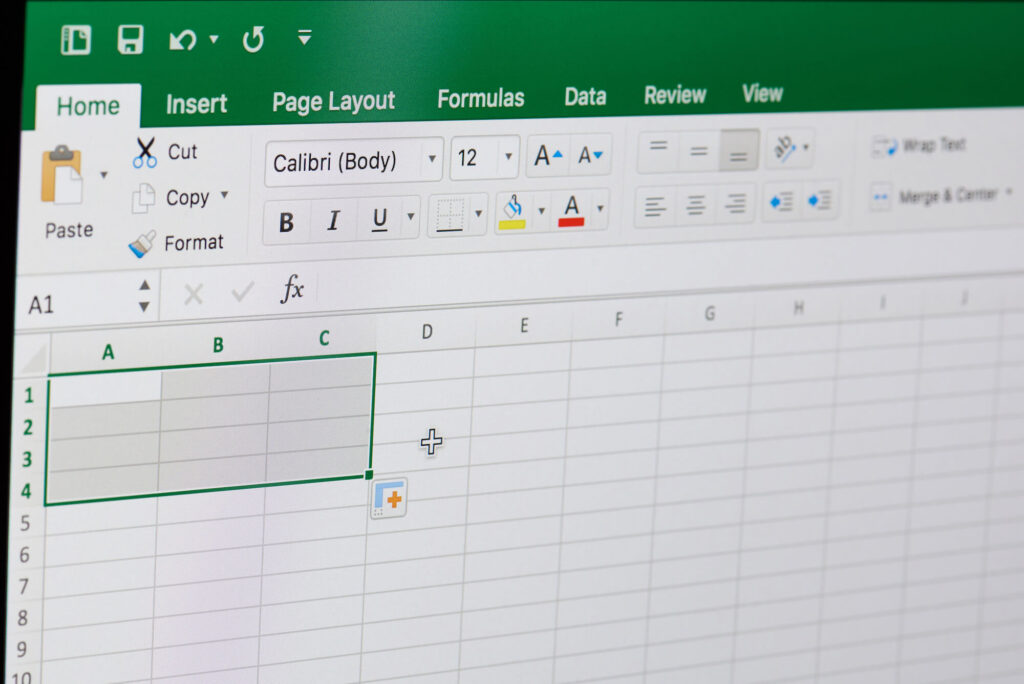
Asset Tracking Spreadsheets: The Run-Down
Before we talk about the cons, we’ll give you the quick run-down of how asset tracking spreadsheets work.
Categories
Asset management Excel sheets need to contain multiple categories to keep information organised. This may include barcodes, product numbers, purchase dates, quantity, subgroups, and condition.
How much data a company keeps will depend on their organisation. Some include photos, information about vendors, warranty details, user information, check-in dates, etc. The common thread is that employees have to be meticulous about entering the information, or else the spreadsheet will be confusing at best and harmful at worst.
Revolutionary
At the time of their introduction in the 1980s, spreadsheets were a revolution:
- Poor penmanship was no longer a problem for companies.
- Data could be copied and saved to external drives.
- Dates could be checked nearly immediately.
- Companies could restrict access to certain employees.
- Information could be quickly streamlined without delay.
So yes, there are some benefits to the free asset tracking spreadsheet that can’t be overlooked. That being said, technology has progressed since the 1980s.
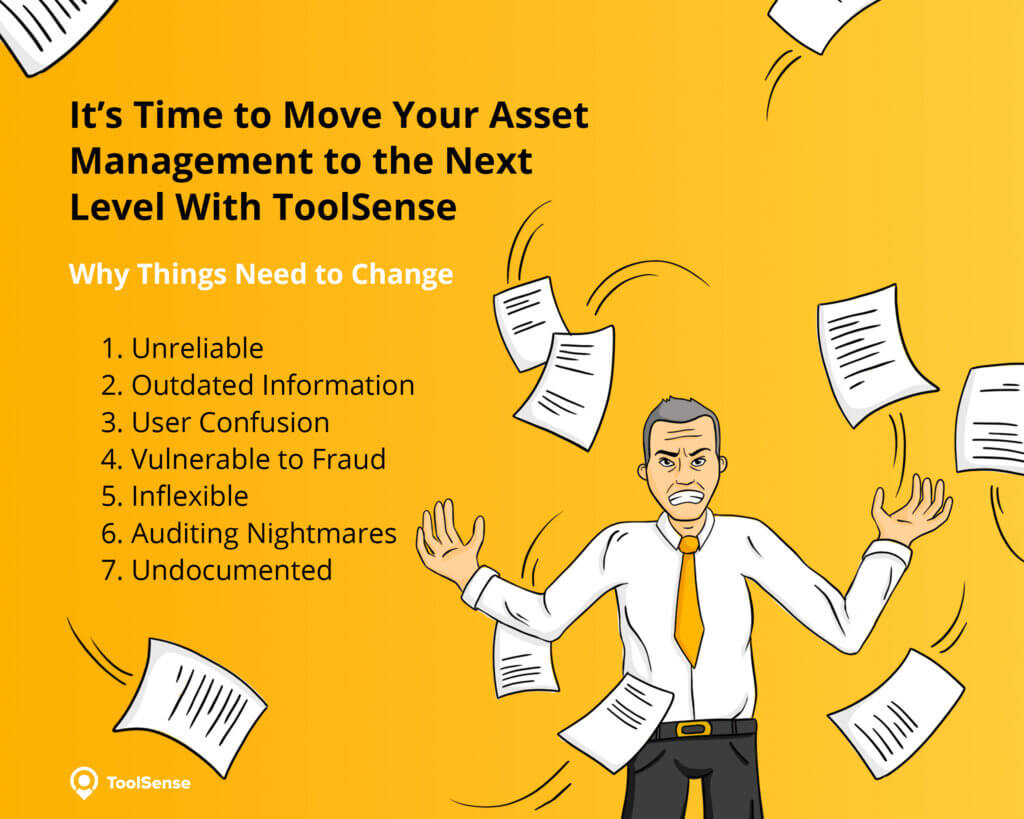
Asset Tracking System Excel: Why Things Need to Change
Excel is still great for some stuff. The formulas and tables are versatile and can be used by employees for anything from one-off presentations to annual reports. But today, it’s just not a smart decision anymore for asset tracking — not when you consider the alternatives.
Asset tracking software (as opposed to asset tracking spreadsheets) is safer, easier, and less prone to security flaws. We’ll look at the major disadvantages of spreadsheets.
1. Unreliable
Every time a company introduces a new category, it opens a literal flood of potential mistakes. The more information you include in Excel asset management, the more the data integrity starts to break down. There are too many anomalous situations where employees don’t know how to classify an item. Product codes are too similar to one another and quickly become confused. Dates are determined by one method for one employee and an entirely different method for another.
2. Outdated Information
How many times have you checked a spreadsheet only to find that information is out of date? In many companies, inactive products are still listed as active and old barcodes are being listed under new product variations. Because information isn’t automatically updated (and because there’s so much information to update), it’s common for employees to use shortcuts or forget about updating spreadsheets entirely. Moreover, a large Excel file is not only sluggish, but also causes human errors and can sometimes lead to data loss.
Managing your assets shouldn’t be hard. That’s why Excel, WhatsApp or Pen & Paper are not the right tools to efficiently manage your asset operations. No matter the manufacturer or type—with ToolSense you are good to go.
3. User Confusion
An equipment tracking spreadsheet is not intuitive when it comes to multiple users. If you want to allow access to more than one person, you have to enable this feature. Once you do, you can end up with 10 different versions of a spreadsheet without a clear indication of how to reconcile them. If several people want to work on a report with the same data, they must all have identical copies of the file. People end up getting locked out of a spreadsheet, even when it’s critical that they update the information immediately. Consolidating data from multiple spreadsheets is also time consuming and can be error prone if several people are managing the process.
4. Vulnerable to Fraud
In most cases, issues with Excel templates for tracking are caused by plain old human error. However, spreadsheets do also open up the potential for fraud, too. Anything from information in the cells to the overall formula can be changed without any alerts to powers that be. Fraud and error cost businesses billions every year, and a forged asset tracker template can play a big role in your bottom line.
5. Inflexible
For the most part, an Excel list should be accessed from a desktop. While tablets and mobile phones are getting better at displaying them, they’re just not a practical solution. When so much of our work is done on the go, Excel templates for tracking limit employee productivity and lead to frustration when checking them. Also, you can’t automate tasks with spreadsheets, or you have to automate them with complex scripts.
6. Auditing Nightmares
Trying to audit anything with an Excel spreadsheet is like beating your head against the wall. Who made the changes? When were they made? Why were they made? Were they a mistake? Whether it’s an internal or external exercise, auditing reaches new levels of annoyance when you’re working with this old-fashioned technology.
7. Undocumented
The number of defunct spreadsheets is epic across companies. These Excel files are typically kept for years in various locations across company equipment. People don’t know why they were created because they’re poorly documented. They end up lost to time or misinterpreted by other people. These kinds of assumptions, particularly when it’s already easy to get the data wrong under perfect conditions, can lead to any number of problems later on. Furthermore, your business data should be stored in a suitable database with proper database backup and recovery solutions.
See How ISS Improved Their Asset Processes With ToolSense
Why Is Excel Free When Asset Management Software Isn’t?
Machine and asset management software offers features that reach far beyond those of Excel. It can be accessed from anywhere, so there’s more updating and less confusion. It’s also capable of keeping up with companies that have endless SKUs and ever-changing business data.
In addition, keep in mind that Excel isn’t exactly free. You might not pay anything upfront, but think about what a single mistake can mean for your assets. What you pay (both in terms of time and money) can be staggering. If you want to safeguard against errors, custom software for asset management is a far more cost-effective option.
Asset Management Software Features You Can’t Deny
Advanced Asset Analytics
Asset management software like ToolSense gives you all the information you need to make informed business decisions. For each asset, you can view locations, runtimes, downtimes, repairs, maintenance schedules, manuals, ticket histories and more – all with just a few clicks.
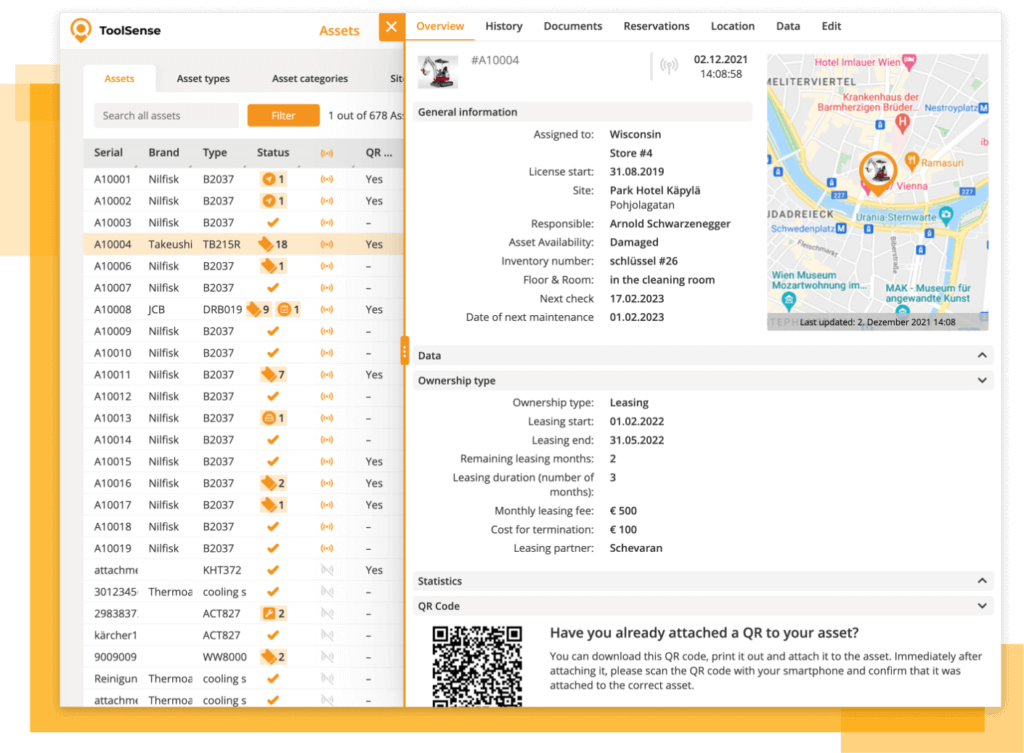
Set Reminders & Alarms
Always missing important appointments? When it comes to maintenance, safety inspections, and audits, it is vital to stay on top of things to ensure the safety of your staff and keep your assets shipshape. ToolSense remembers these dates for you.
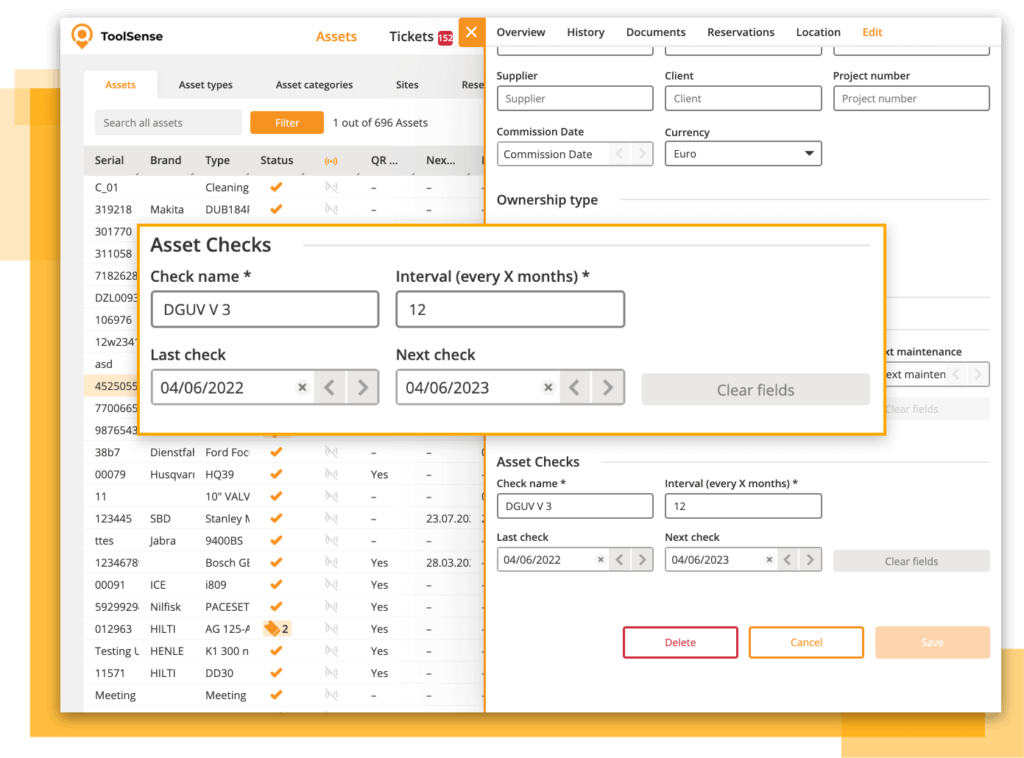
Asset Tracking
Always knowing where your equipment is and what shape it is in is vital to operating a successful business. A process for tracking assets is especially important in construction, the cleaning industry, manufacturing, and many more because these businesses rely on their assets and knowing their location at all times.
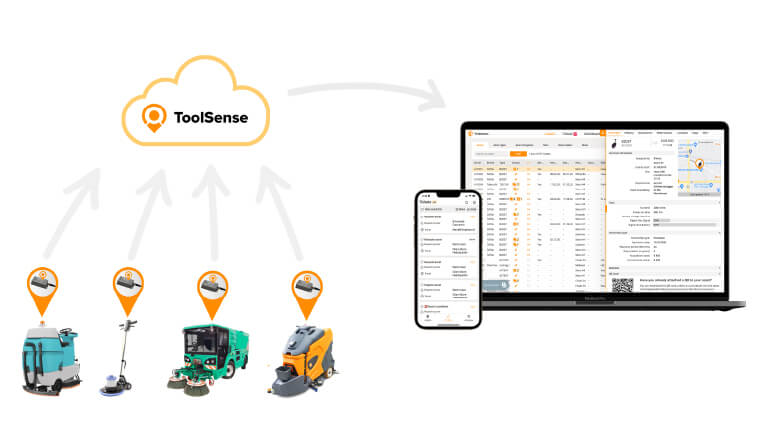
Stay Independent
Often, asset management solutions are tied to a specific manufacturer or brand. If your company operates assets from multiple brands, ToolSense is the best asset tracking software for you. All your existing assets – regardless of brand – can be entered into the system with just a few clicks via an Excel import.
What Are the Pros and Cons of Using Excel Spreadsheets for Asset Tracking?
Excel spreadsheets eliminate the need for paper tracking. Employees can check information immediately and update it as needed. Companies can restrict access to keep certain data safe.
The Excel spreadsheet disadvantages include unreliability, a higher chance of fraud, and user confusion. Too many people have access to alter the data, and multiple versions of the same spreadsheet can be saved across multiple devices. Asset tracking is ultimately too unwieldy to leave to Excel.
ToolSense is trusted by 700+ companies worldwide



Why You Should Use a More Modern Software Tool
As we can see, free asset management software Excel is outdated. An Excel plan template doesn’t allow for tracking tags. It can’t be accessed from any device. Its accuracy just can’t compare to the automated versions of today. In short, if you want to learn how to create an inventory tracking system in Excel, you’re far better off opting for a different methodology.
ToolSense can provide you with bespoke software that can keep up with emerging needs better than Microsoft Excel or Google Sheets asset management. We’re here to keep your inventory straight, so you don’t have to rely on inaccurate and old-fashioned technology.
How ToolSense Improves Your Asset Management
FAQ
If you’re still flip-flopping between the two, we boil down the basics in this section.
Ideally, we recommend Excel for storing simple data, basic formulas, and straightforward reports. Because these spreadsheets are limited in terms of space, capabilities, and functionality, Excel is not a good candidate for asset tracking.
Not anymore. While this was cutting-edge technology 30 years ago, the truth is that it just hasn’t evolved to meet the needs of asset management today. Unlike more advanced software tools of the day, Excel is a direct path to outdated information and mistranslated data.
If you’re interested in exporting your data from Excel to a more intuitive asset tracking tool, all you have to do is click on the ‘File’ tab and select either ‘Export’ or ‘Save as’. From there, you’ll need to upload to the app. Thankfully, a program from ToolSense makes it simple and fast to get everything from Excel moved over to a smarter solution.
Asset-tracking spreadsheets need to include as much identifying information as possible. This makes it possible for people to confirm details, keep inventory straight, and ensure that stock levels are where they need to be. From warranties to user info to vendors to photos, these files should ideally be a one-stop shop for practically any product question. It’s easy to see why a spreadsheet (even one as competent as Excel) just isn’t built for that kind of data dump.

